
HMS Royal Oak was a Prince Consort-class armoured frigate built for the Royal Navy in the 1860s. The lead ship of her class, she is sometimes described as a half-sister to the other three ships because of her different engine and boiler arrangements. Like her sisters, she was converted into an ironclad from a wooden ship of the line that was still under construction.

HMS Ocean was the last of the Royal Navy's four Prince Consort-class ironclads to be completed in the mid-1860s. She was originally laid down as a 91-gun second-rate ship of the line, and was converted during construction to an armoured frigate. The ship spent the bulk of her career on the China Station and served as flagship there for a time. Upon her return to Great Britain in 1872 her hull was found to be partly rotten and she was placed in reserve until she was sold for scrap in 1882.

HMSZealous was one of the three ships forming the second group of wooden steam battleships selected in 1860 for conversion to ironclads. This was done in response to the perceived threat to Britain offered by the large French ironclad building programme. The ship was ordered to the West Coast of Canada after she was completed to represent British interests in the Eastern Pacific Ocean. Zealous became the flagship for the Pacific Station for six years until she was relieved in 1872. She was refitted upon her arrival and subsequently became the guard ship at Southampton until she was paid off in 1875. The ship was in reserve until she was sold for scrap in 1886.

HMS Lord Warden was the second and last ship of the wooden-hulled Lord Clyde class of armoured frigates built for the Royal Navy during the 1860s. She and her sister ship, Lord Clyde, were the heaviest wooden ships ever built and were also the fastest steaming wooden ships. They were also the slowest-sailing ironclads in the Royal Navy.
The Danish ironclad Dannebrog was an armored frigate of the Royal Danish Navy. She was built as a sailing 72-gun ship of the line, but was reconstructed into a steam-powered ironclad in the early 1860s. She had an uneventful career before the ship was stricken from the Navy List in 1875. The ship was converted into an accommodation ship that same year and served until she became a target ship in 1896. Dannebrog was broken up in 1897.

The Danish ironclad Lindormen was a monitor built for the Royal Danish Navy in the 1860s. She was scrapped in 1907.

The Danish ironclad Gorm was a monitor built for the Royal Danish Navy in the 1860s. She was scrapped in 1912.

The Danish ironclad Odin was a central battery ironclad built for the Royal Danish Navy in the 1870s. She was scrapped in 1912.

The Spanish ironclad Tetuán was an armored frigate built in the royal dockyard at Ferrol during the 1860s for the Spanish Navy. She was captured by rebels during the Cantonal Revolution in 1873 and participated in the Battle off Cartagena. While under repair after the battle, the ship was destroyed by fire and broken up in 1874.

The Spanish ironclad Arapiles was a wooden-hulled armored frigate bought from England during the 1860s for the Spanish Navy. Begun as an unarmored steam frigate, she was converted into an ironclad while under construction. Damaged when she ran aground in early 1873, she was under repair in the United States during the Virginius Affair later that year as tensions rose between the US and Spain over the incident. The ship was hulked in 1879 and the poor condition of her hull forced her reconstruction to be cancelled in 1882. Arapiles was scrapped a year or two later.

The Spanish ironclad Méndez Núñez was a wooden-hulled armored corvette converted from the 38-gun, steam-powered frigate Resolución during the 1860s after the ship was badly damaged during the Chincha Islands War of 1864–66. She was captured by rebels during the Cantonal Revolution in 1873 and participated in the Battle off Cartagena before she was returned to government control after Cartagena surrendered in early 1874. The ship was stricken from the Navy List in 1886 and broken up ten years later.
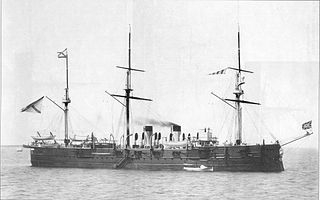
The Russian cruiser Minin was an armored cruiser built for the Imperial Russian Navy during the 1860s and 1870s. She was renamed Ladoga in 1909 when converted to a minelayer. The ship was sunk in 1915 when she struck a mine laid by a German submarine in the Baltic Sea.
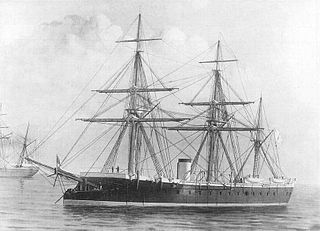
The Russian ironclad Sevastopol was ordered as a 58-gun wooden frigate by the Imperial Russian Navy in the early 1860s, but was converted while under construction into a 32-gun armored frigate. She served in the Baltic Fleet and was reclassified as a training ship in 1880. Sevastopol was decommissioned five years later, but was not sold for scrap until 1897.
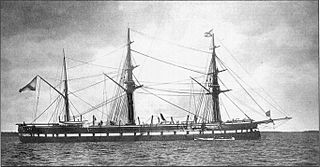
The Russian ironclad Petropavlovsk was a 22-gun armored frigate in the Imperial Russian Navy during the late 19th century. She was originally ordered as a 58-gun wooden frigate, but she was reordered as an ironclad while under construction and subsequently converted into one. She served as the flagship of the Baltic Fleet during the 1860s and 1870s. The ship was decommissioned in 1885, but was not sold for scrap until 1892.

The Russian ironclad Kreml was the third and last Pervenets-class broadside ironclad built for the Imperial Russian Navy during the mid-1860s. She joined the Baltic Fleet upon completion and accidentally sank a Russian frigate in 1869. The ship was assigned to the Gunnery Training Detachment in 1870 and was frequently rearmed. Kreml sank in shallow water after a storm in 1885; she was refloated and returned to service. The ship was placed in reserve in 1904 and disarmed the following year before being sold for scrap in 1908.
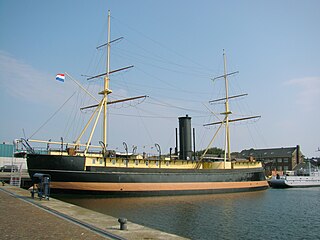
The Schorpioen-class monitors were a pair of ironclad monitors built abroad for the Royal Netherlands Navy in the 1860s. They had uneventful careers and were stricken from the Navy List in the first decade of the 20th century. Stier became a target ship and was sunk in 1925. Schorpioen was converted into an accommodation ship in 1909. She was captured by the Germans during World War 2, but survived the war. She remained in service until 1982 and then became a museum ship.

The Buffel-class monitors were a pair of ironclad monitors built for the Royal Netherlands Navy in the 1860s. They had uneventful careers and were stricken from the Navy List in the late 1890s. Guinea was scrapped in 1897, but Buffel was hulked and converted into an accommodation ship in 1896. She was captured by the Germans during World War 2, but survived the war. She became a museum ship in 1979.
The Greek ironclad Vasilefs Georgios was an armored corvette built in Great Britain for the Royal Hellenic Navy during the 1860s. She became a cadet training ship before she was stricken from the Navy List in 1912. The ship was scrapped in 1915.
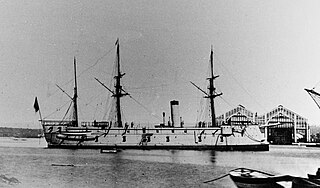
The Drache-class ironclads were a pair of wooden-hulled armored frigates built for the Austro-Hungarian Navy in the 1860s, the first ironclads built for Austria-Hungary. Ordered in response to a pair of Italian ironclads in 1860, Drache and Salamander were laid down in early 1861, launched later that year, and completed in 1862. They participated in the Austrian victory over the Italians in the Battle of Lissa, where Drache destroyed the coastal defense ship Palestro, one of two Italian ships sunk in the action. Both ships were withdrawn from front-line service in 1875. Drache's hull was in poor condition, so she was discarded and eventually broken up in 1883, but Salamander became a harbor guard ship. She was hulked in 1883 and converted into floating storage for naval mines before being scrapped in 1895–1896.

The Russian monitor Admiral Spiridov was the name ship of her class of monitors built for the Imperial Russian Navy in the late 1860s. The ship was assigned to the Baltic Fleet upon completion and remained there for her entire career. Aside from an accidental collision her service was uneventful. The sister ships were reclassified as coast-defense ironclads in 1892 before they became training ships in 1900. Admiral Spiridov was stricken from the Navy List in 1907 and became a coal-storage barge. Her ultimate fate is unknown.


















